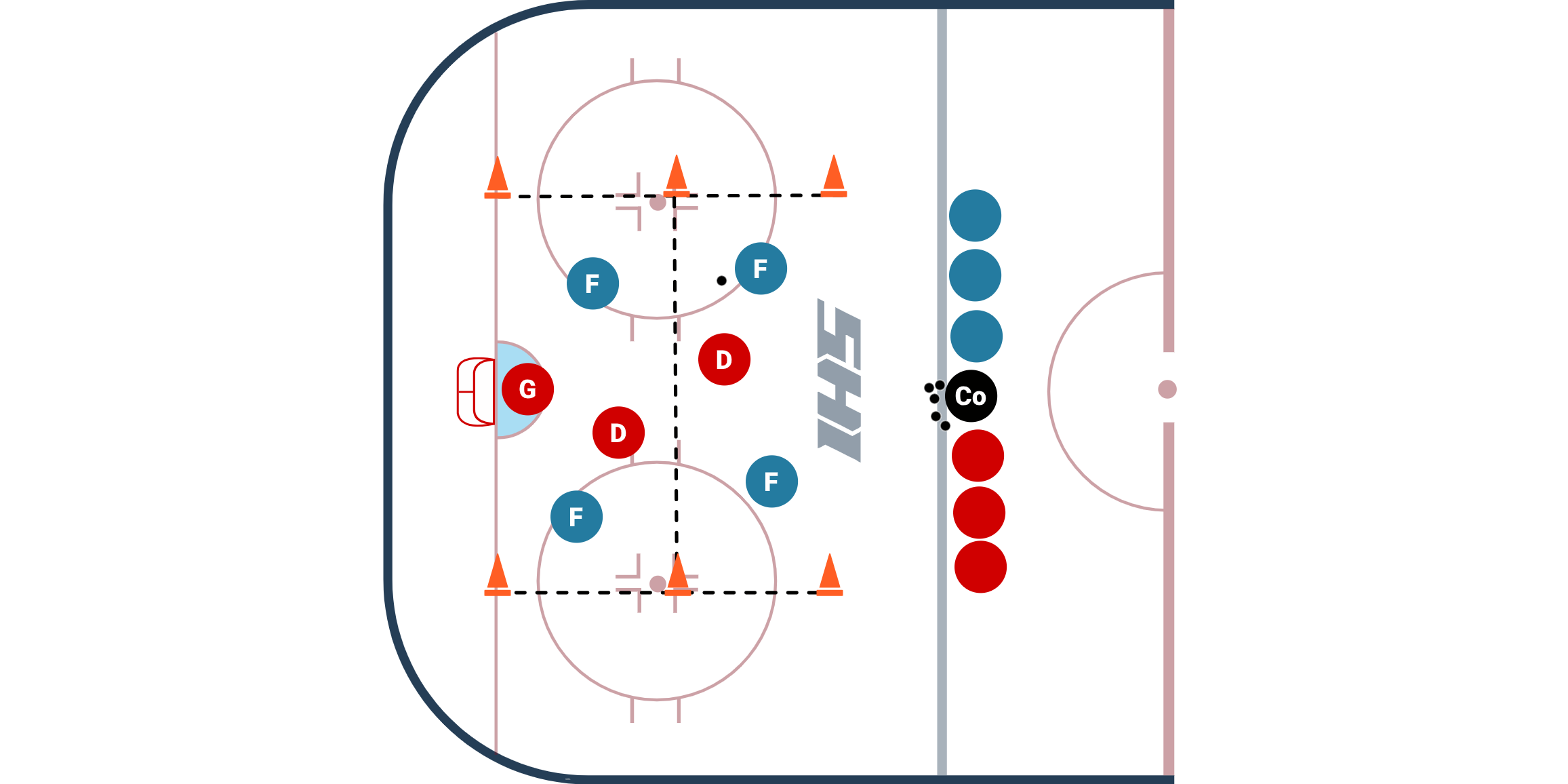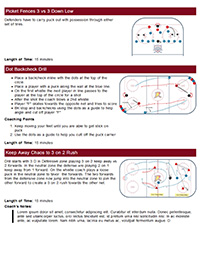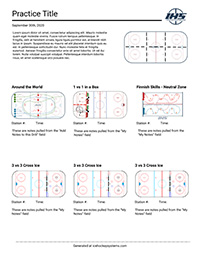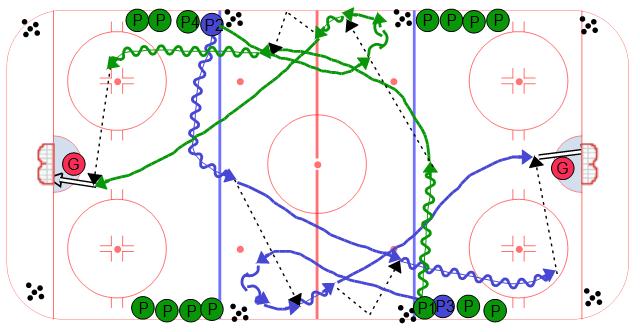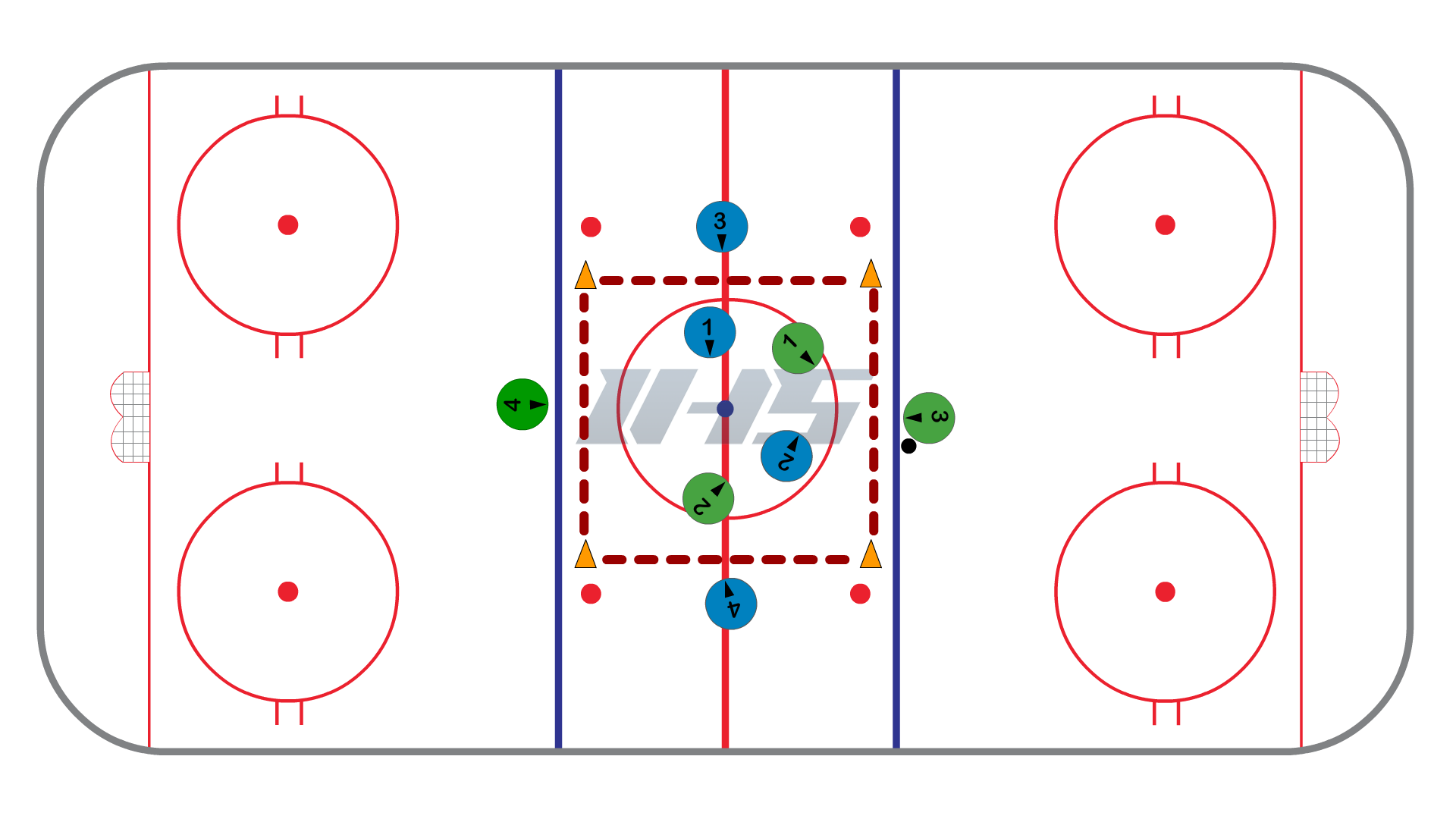
U12 - Passing, Puck and Player Movement
U12 - Passing, Puck and Player Movement

This practice is all about passing, puck movement, and player spacing to keep possession and create scoring opportunities. We're looking to challenge and train players to find space and be thinking about the puck as the present and the space as the future.
Be sure to encourage and acknowledge good communication between teammates.
You can add additional challenges to various games based on certain skills or plays you are working on with your team. For example, in a small area game, counting certain types of passes that you are encouraging (one-touch, sauce, chip passes, etc.) as extra points.
Practice Layout

Gates of Buffalo Small Area Passing Game
The major concept of the Gates of Buffalo Small Area Hockey Game is to practice moving to open space, communicating verbally and non-verbally with teammates, so they can score Goals by passing through Gates.
This game framework will help players learn to play with their head up, communicate with teammates and move to open space.
As a coach, If you commit to working on activities like this instead of memorization drills for a portion of each practice, you will marvel at how your team begins to work together. It will look extremely messy at first, but players will get better with each repetition. Moving to open space, and moving the puck will eventually become second nature to the team.
GAME OBJECTIVE
- Score as many goals as possible by passing through the "Gates."
- You can not pass through the same gate twice in a row!
SETUP & ACTIVITY VARIABLES
- Players: great for 3, 4 or 5 players at a time.
- Time: You can rotate through groups of players in 30, 45 or 60 second shifts and count how many goals are scored.
- Or you can set a number of goals (let's use 5 for example) and stop the watch after 5 goals are completed.
- 5 players can be participating in the activity, while another 5 rest. Blow the whistle and the next 5 jump in. It gets fun when the teams compete against each other!
- Space: can be set up to be within a zone, or half of a zone (station) or a smaller area. The smaller the space, the more challenging it will be for the players as they are forced to make quicker decisions.
- Added Challenge: add obstacles within the space to challenge the players further.
- Tires, cones, sticks, defenceman, etc placed in the space will make it harder to pass and skate around. As time goes on the added obstacles will help improve their reaction & decision making.
- Group Competition: After the group gets comfortable with the exercises, you can add a natural element of competition between the groups by counting the number of successful goals made in the specified amount of time.
- Or you can time each group and see how fast they can complete 5 (or any other number) goals. You will marvel at how the natural element of competition between groups will make the game more intense, competitive and fun!
- With a Goalie: You can require the players to make 2 (or more) passes through a gate before they can shoot on net. After they shoot on net, they need to make the required number of passes through the gates again.
- Pucks: You can add in 2 or more pucks at a time to make players pay more attention to the game and their surroundings.
- Gates: You can add 3 or more gates. They can be made of tires, cones, pucks and other materials. Change up the sizes of the gates for an extra challenge. The smaller the gate, the more challenging the game is!
- 3 vs 3 Game: You can setup gates and make the game 3 v 3, 3 vs 2, or 3 vs 1 so there is another team working to prevent scoring on the gates. Adding additional players for the team to play against will give the game a whole new spin. View a video demo of the 3 vs 3 game setup.
Setup Suggestions for Elite Players
- Make the gates much smaller.
- You can add a hockey stick at the bottom of each gate so players must "sauce" through a gate and over the stick for the point.
- Add various obstacles on the ice such as sticks that players must be aware of and pass around or sauce over.
- For extra fun, add a defenceman. Or play 3 vs 2 or 3 vs 3.
- If you have a goalie, require 2 or more passes through the gates before players are allowed to take a shot on net.
COACHING POINTS
- Encourage players to always move to open space on the ice. Do not allow them to stand still and pass the puck back and forth.
- Encourage players to find "passing lanes" to allow good passes.
- This skill is extremely valuable for youth players to work on. Finding passing lanes when you have the puck and jumping to open space when you don't have the puck so your teammate can pass to you is extremely beneficial during games.
- Encourage verbal communication (calling teammate by name, saying you are open, etc).
- Encourage non-verbal communication (good eye contact, showing a passing target, tapping a stick, etc).
- Allow players to make mistakes. It will take time to get comfortable with these activities. But as time goes on you will see them picking their head up to make a decision, which is the goal of this small area game.
Why do we call this small area game "Gates of Buffalo?" The game has been called "gates" in the world of soccer and we decided to add Buffalo to it for two fun reasons: First, IHS has strong ties to Buffalo, NY. Secondly, the imagery of a Buffalo can help drive home to your youth players why you are practicing this game. If you do not pick your head up and use your teammates while playing the game of hockey, you run the risk of getting trampled by the other team. This can feel like getting run over by a Buffalo (physically or on the scoreboard). This game helps prevent both of those situations by forcing players to keep their head up while communicating and working with teammates to score goals.

Cross Fire Possession Game
This game is all about passing, possession, and awareness. Set up a square area with cones as shown in the diagram. The size of the square can vary depending on the age and skill level of the players. Larger areas are needed for less skilled players while smaller areas will challenge players with higher levels of skill. Thre are size players on each team. Two players on each team are inside the box while the other two players are on the outside of the box on opposite sides.
The object of the game is to get the puck to go from one player on the outside of the box to their teammate on the opposite side using the players in the middle. When a player on the inside of the box gains possession of the puck they will look to get it to one of their teammates on the outside of the box. The player on the outside of the box must try to pass to one of the players on the inside of the box. If they make a successful pass to one fo their teamates inside the box then the players inside the box work together to get the puck to their teammate on the opposite side.
Coaching Points
- Players need to protect puck until they can make a play.
- Stress movement without the puck.
- Empasize pass and move and give & gos.
After each rep, spot pucks on the outside of the square in the NZ for players that were just passing to pick up and go shoot. Place coaches or players waiting inside the zone for the puck carriers to make a move around.
Half Horse Shoe Chip
There are lots of good hockey drills that start with the four lines at the blue lines. They are nice because you can go from one drill to the next without much down time in between drills. Here is another good hockey drill that uses the four lines. Two players from the diagonal corners will go at the same time. The first player will carry the puck across the ice as though they are skating around the neutral zone face off dot. The second player in line will skate straight ahead and open up to receive a pass from the other line's first player. Once this player receives the pass they step to the middle of the ice so they can chip the puck off the boards at a better angle. The player that passed the puck picks up the chip with speed and carries it into the zone. The player that chips the puck has to sprint to the far post and receive a pass back from the first player.
Continuous In Zone 3 vs. 3 Game
A continuous 3 vs. 3 hockey game that puts the defenders at a big disadvantage since they will be double shifting. Players will be tired so it is important for them to focus on battling, good positioning and habits during this game.
Setup:
- 3 defenders start at the blue line and 3 forwards start in the center ice circle.
- The game starts with the coach passing the puck to one of the 3 forwards (this begins the 3 vs. 3).
- Forwards try to keep possession of the puck and score.
- The defenders can end the game by skating the puck out of the zone or passing the puck to the forwards that are next in line.
- If a goal is scored, or the goalie freezes the puck, or the puck goes out of play, the coach has the option to chip another puck in the zone, or pass to the next forwards in line.
- When the shift ends (either with a goal, the defense getting the puck out of the zone, or a coach's whistle), the forwards switch to defense and the new forwards start the 3 vs. 3.
- Keep Score: 3 points for a goal, 2 points for the defense skating the puck out of the zone, 1 point for the defense passing the puck out of the zone, and 0 points if the coach blows the whistle and changes lines.
Coaching Points:
- The defense will be tired since they will be "double shifting." Encourage good positioning and habits. Stick on the ice!
- Both teams should not be afraid to hold on to the puck, and protect it until they are able to make a play.
- Both teams should work on verbal & non-verbal communication with their teammates.
- Compete to score points for your team! Celebrate points!
Variations:
- Can be set up on 1/4 ice (view animation here).
- Can be 1v1 (view example), 2v2 (view example), 3v3, or 4v4.
- Can add "gates" (like Picket Fences Game) at the point that the defenders must skate through.
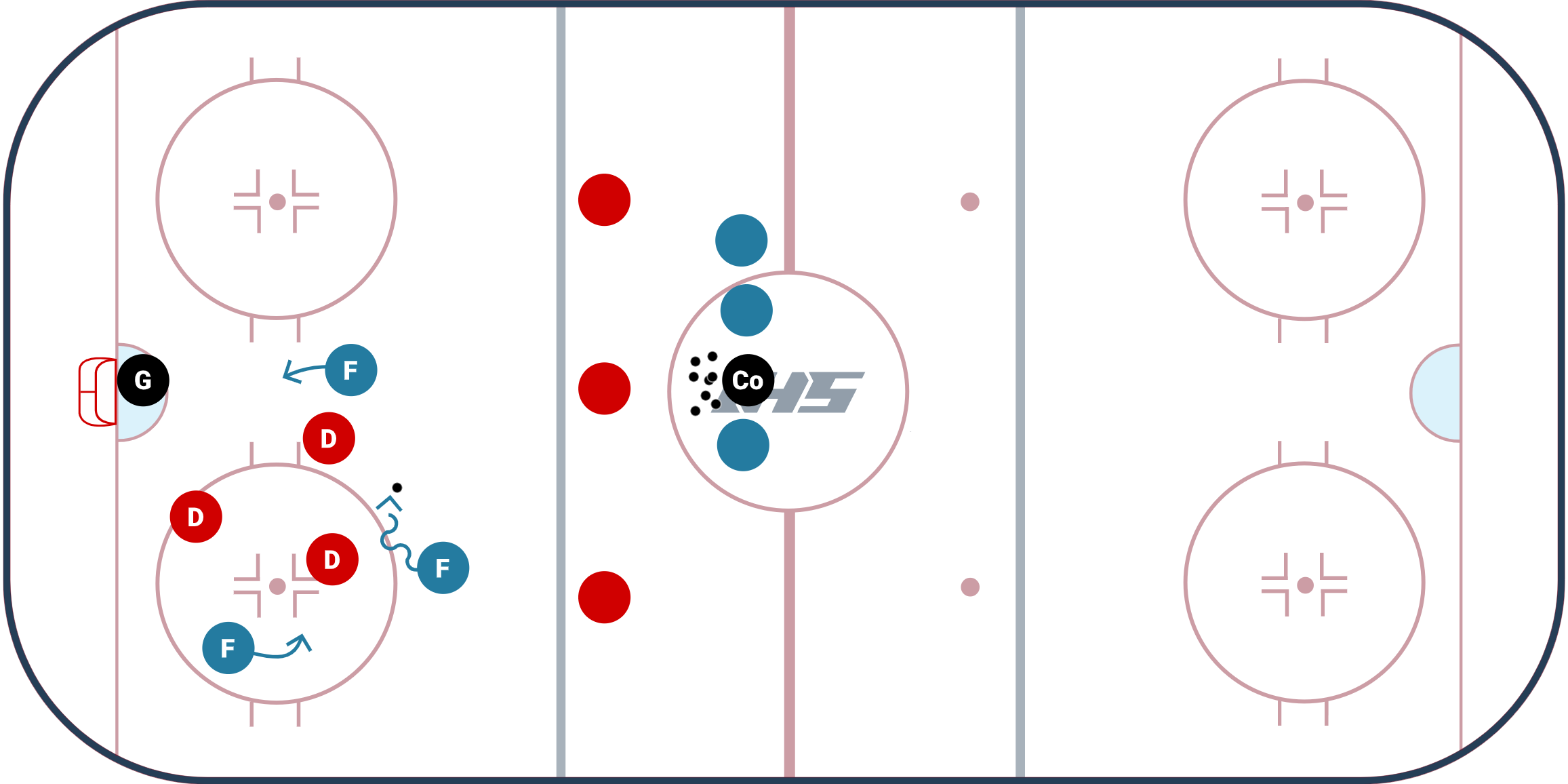
Neutral Zone 3 vs. 3 Game
The Neutral Zone 3 vs. 3 Game is a great small area game that creates a lot of turnovers and transitions, which is common for the neutral zone. To be successful, teams will need to play with their head up, keep their sticks on the ice and communicate with their teammates.
Game Setup
- Teams line up in opposite corners of the neutral zone (as pictured in the video and diagram).
- Each team has a coach (or player) that is on their team and is lined up on the same blue line as them.
- Each coach (or player) needs to be aware of the game and they are required to pass their team the puck if the puck goes out of play, a goal is scored, a goalie makes a save, or the puck goes past the blue line on their end. Players can intentionally pass the puck out of their end to create a "breakout" situation where the coach will pass their team a new puck (you can see this example in the video if you watch closely).
- If the puck goes past the blue line it is out of play.
- Each team battles to score.
- The shift length should be anywhere from 15 - 45 seconds long.
Coaching Points
- Head up: Everyone with and without the puck needs to keep their head up and on a swivel. It is important to know where the puck is, where your teammates are and where the opposition is.
- Stick on the ice: This is important for the forwards (because it shows your teammate where you want the puck) and for the defense (it allows you to angle and cut off passing lanes).
- Communicate: There will be lots of new pucks and transitions so it is important to communicate with your teammates and coaches (or players) who are passing the new pucks.
- Move to space: Forwards should jump to open space and become an outlet for their teammate if they do not have the puck.
Variations:
- You can play this game in a 2v2 or 3v3 setup.
- You can allow players to pass the puck to their coach. This variation was not shown in the video.
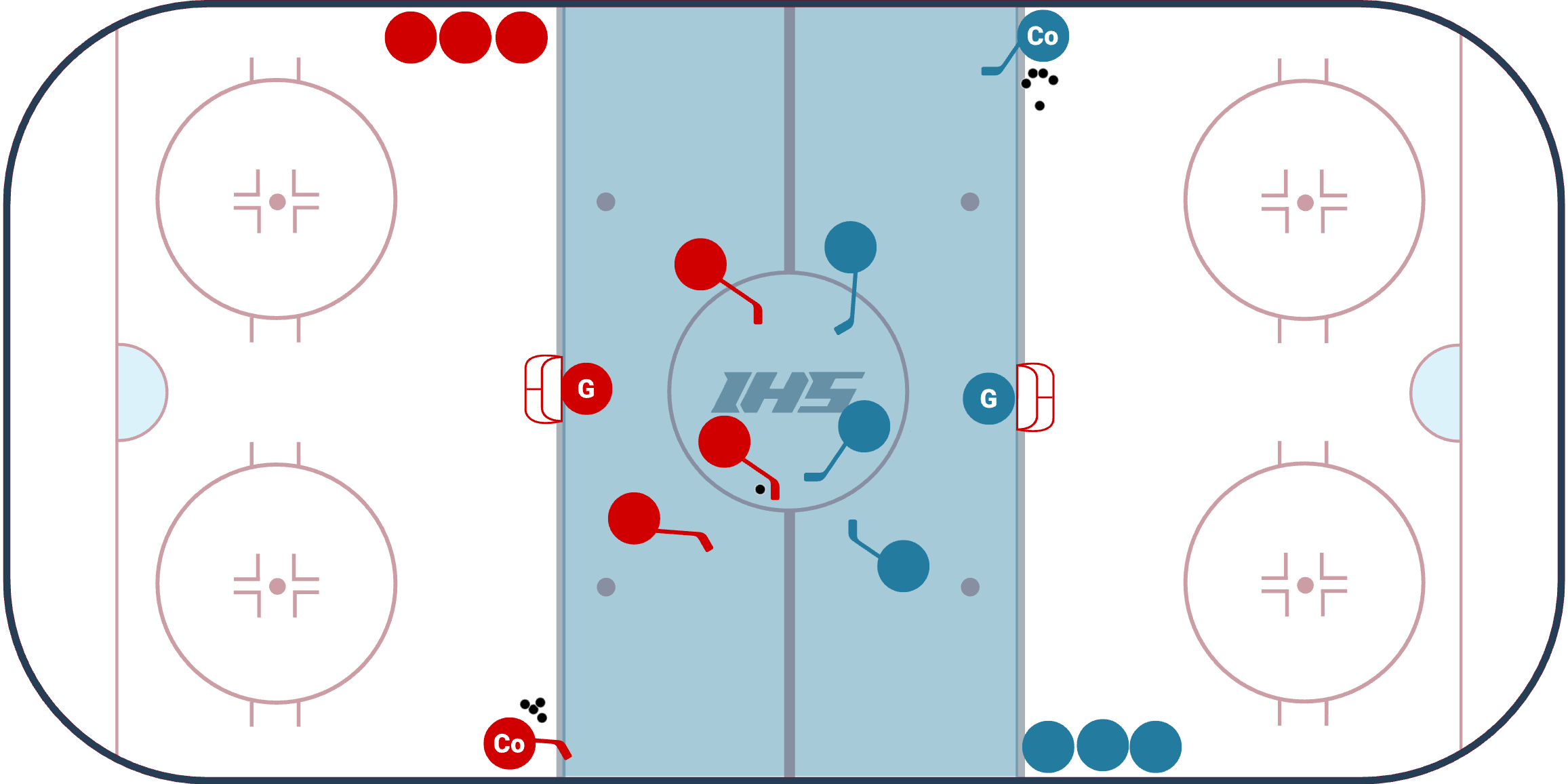
Swiss 4 vs. 2 Scoring Game
Swiss 4 vs. 2 Scoring Game: A fun small area hockey game that sets up the offense to work on generating passing & scoring opportunities by keeping head up, being patient, using deception and communicating with teammates.
Swiss 4v2 Scoring Game Set Up:
- Split team into two different colors.
- Divide up the ice into two sections:
- If you have a marker: draw a line through the dots on the offensive zone (parallel to the goal line). Draw another line from the goal line to the blue line about 5 feet from the hash marks (on both sides).
- If you do not have a marker, or time to draw lines, use the hash marks, or cones as a center divider.
- You can also use a smaller area of the ice if you would like.
The Game is, in essence, two 2v1’s that are constrained within a tight space. The offense is trying to score.
- There is a High 2v1 (above the hashmark) and a Low 2v1 (below the hashmark)
- The Offensive players are in one color and the Defensive players are in another color
Start of Game:
Coach gives a puck to the offensive players who can move within their dotted area.
- the Offensive players look to attack the net and score on the 4v2
- the Offensive players can shoot at any time and pass to any other teammate
- the Defensive player tries to have an active stick and deflect, knock away the puck
- the Defensive player must also defend (stay) within his dotted area
Offense gets a new puck IF:
- the Offensive team scores
- the goalie makes a save and the puck goes outside the boundary
Coach yells CHANGE IF:
- The Offensive Players miss the net
- Goalie freezes the puck
- The Offense gets their puck knocked our of the boundary
- Take longer than 5 seconds to shoot
CHANGE Rotation:
- The two Offensive players on the goal line (low 2v1) are out of the game and they go to the back of the line
- The two Defending players now take up Offensive positions on the goal line (low 2v1)
- The two Offensive players above the Hash Marks (high 2v1) now are the two Defending Players
- One must play the low 2v1 and one player must play the high 2v1
- Two new Offensive Players in line become part of the game and get a new puck from Coach
Offensive Principles:
- Know your options before you get the puck
- Get your head up and scan the environment
- What hands are my teammates (are their 1 timer options?)
- Can I deceive the defender and creating a shooting/passing lane?
- Get your head up and scan the environment
- If you can Attack the Net with a Shot, Attack
- Missing the Net means you now must play Defense (Reward Shots on Net and Scoring Chances)
Defensive Principles:
Teach 2v1 defending based on organizational ideals. For many teams,
- Allow the goalie to take shot & defender takes away pass across the Royal Road (forcing the goalie to go side to side)
- Play Cat N’ Mouse with the Offensive Player with the Puck
- Body and Stick position can limit his options
- Knock away loose pucks out of danger (and then play Offense)
Coach sets a Time Limit or A Game up to a certain number of Goals. Goalies should work on tracking the puck and should be switched every 2 minutes as there will be a lot of movement.
